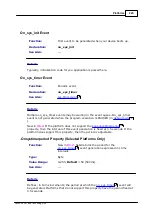
227
TIDE and Tibbo BASIC User Manual
©2000-2008 Tibbo Technology Inc.
serial port will discard the parity bit so the RX buffer will only get "pure" data.
Full-duplex operation
The full-duplex mode of operation is suitable for communicating with RS232,
RS422 devices, 4-line RS485 devices, and most TTL-serial devices. Naturally,
external transceiver IC is needed for RS232, RS4222, or RS485. TTL serial devices
can be connected to the serial port lines directly in most cases.
In the full-duplex mode, the RTS output and CTS input lines can be used for
optional flow control. The RTS output is low whenever the serial port is ready to
receive the data from "attached" serial device (port is opened and the RX buffer
has at least 64 bytes of free space). The RTS line is high whenever the serial port
is closed or the RX buffer has less than 64 bytes of free space left. Figure below
illustrates RTS operation.
All diagrams show TTL-serial signals. If you are dealing with the lines
of the RS232 port you will see all signals in reverse!
The CTS input is used by the serial port to check if attached serial device is able to
accept the data. The serial port will only start to send the data when the CTS input
is low. The serial port will stop sending the data once the line goes high. Note, that
some Tibbo devices have a hardware buffer called "FIFO" ("fist-in-first-out" if you
really need to know ;-). Once the TX data is in the FIFO it will be sent out even if
the CTS line goes low. Therefore, after the attached serial device switches the CTS
line to low the serial port may still output the number of bytes not exceeding the
capacity of the FIFO. See "Platform-dependent Programming Information" topic
inside your platform specifications section for the serial port FIFO size on your
platform.
















































